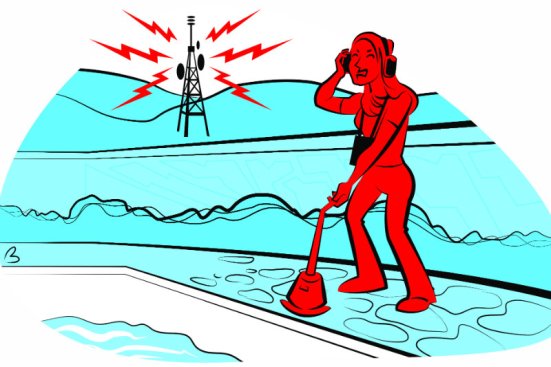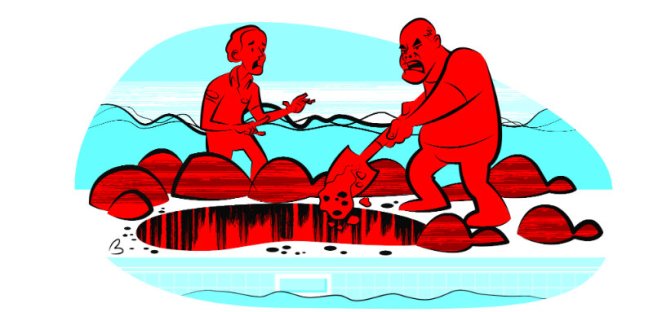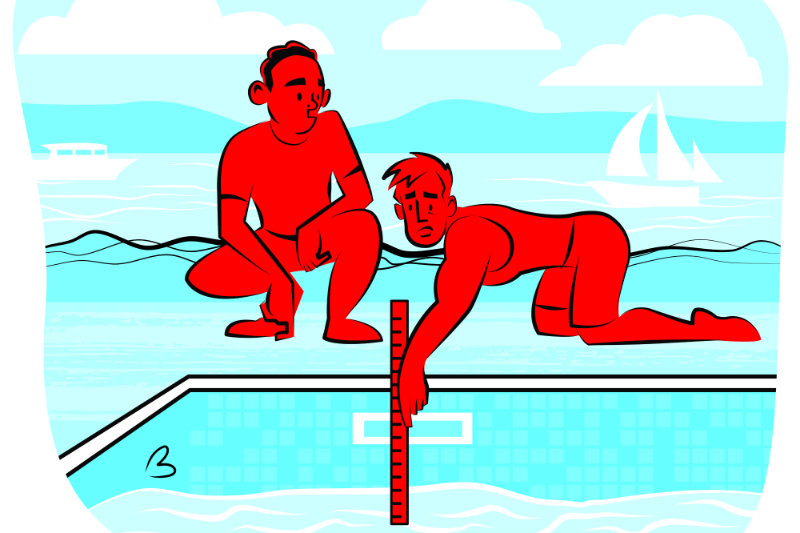Leak detectors work by the mantra “Elimination leads to location.” By methodically eliminating where the leak is not, they hone in on the precise spot where a pipe or shell is damaged.
They’re equipped with an arsenal of sophisticated tools. They can isolate lines and pressurize them with air and water to see or hear if there are any breaches in the pipe. Guiding small cameras through the lines, they can get visible confirmation or using audio equipment, these pros hear where the pool is losing water.
They are detectives. And some cases are harder to crack than others. Here, leak specialists discuss their most challenging jobs and elusive leaks.
Fluctuation frustration
Water loss is generally pretty easy to explain, but water addition? That can be a real conundrum.
At first, Rob Angelo wasn’t certain that the pool was leaking. He performed the tests. There was no indication that the lines were compromised. So he made a mark at the skimmer and advised the homeowner to keep an eye on the level.
Then he received a curious phone call.
“He homeowner asked ‘Hey, what did you fix?’ I told him we didn’t find anything,’” recalls Angelo, owner of Aqua Leak Detection in Venice, Fla. But the homeowner insisted that the pool was holding water.
Angelo inspected the vessel again and, sure enough, the water had risen since his last visit. There was no auto fill, the homeowner swore he didn’t add water and it hadn’t rained.
Angelo wondered: What could have topped off the pool?
He received another call the following day: The water level mysteriously dropped four inches.
It took several perplexing visits, but Angelo began putting the pieces of the puzzle together: The home was located on St. Armonds Key on Sarasota Bay. And the homeowner mentioned something that triggered a real “Aha!” moment for Angelo. He said he had come back from fishing on the bay during low tide when he noticed the pool had lost several inches.
Angelo: “And I starting thinking about it and said ‘What did you say?”
Was it possible that the pool, on a property surrounded on all sides by water, was being affected by the tidal currents? He compared the dates of recorded water loss with a tide chart. There was a definite correlation.
“I was like ‘You’ve got to be kidding me,” Angelo says.
The pool was fiberglass and the main drains and lighting fixtures were compression fit. During low tide, water would escape through the gaskets, and during high tide, groundwater seeped back into the pool —hence the fluctuating level.
An easy fix, a perplexing case.

Tim Bobko
Not music to her ears
Some jobs have everything working against you.
Under normal conditions, Christine Pearson is able to pinpoint the precise location of water loss with few complications. But conditions at this large commercial pool were anything but normal.
Pearson is the owner of Excalibur Leak Detection in Columbia, Md. Even with 20 years of experience, she’s never encountered a job as frustrating as this.
The pool was losing approximately 20,000 to 40,000 gallons a day. It was apparent that the skimmer and return lines were leaking in multiple places. Normally, she’d be able to use a whole arsenal of leak detection equipment to zero in on the problem spots, but numerous factors played against her.
The design of the return fittings prevented her from running a small camera or a microphone through the pipes. Additionally, due to the pump room being below grade, she was unable to access the pipe from that location to utilize either of those methods while maintaining enough water in the pipe for the inspection (a standpipe was also not possible due to the design).
Pumping helium into the pipes and using a gas sniffer was out of the question due to the volume needed to fill the hundreds of cubic feet of pipe. So, she had to rely on her ears.
She pressurized the lines and, with the help of a listening device, scanned the ground for telltale gurgling sounds. However, she encountered yet another problem: Interference from a nearby radio tower all but drowned out leak sounds with rock music.
Despite these factors, she persevered. She had to really focus and listen very carefully as some sections of the pipes were three feet below ground, making sounds extremely faint. She also found that she could use her body to block the airwaves by keeping herself between the tower and the listening device.
“Remember how in the ’70s you hold your arm up with the antennae to get a good signal on a TV set?” Pearson asks. “I’m doing that to cancel the signal.”
Hey, whatever it takes.
Living room deluge
Some leaks reveal themselves in unexpected places — like a living room.
Darren Merlob is the owner of LeakTronics, a manufacturer of leak detection equipment and a service company called Cal Tech Pools.
He was performing what he anticipated would be another routine inspection in suburban Los Angeles when he got the surprise of his career. Using a pipe mic, Merlob heard the leak inside the skimmer line. Whether or not there were more leaks along the line, however, could not be immediately determined.
“We knew where we heard the leak, but that doesn’t always tell whether or not there are multiple leaks in one pipe,” Merlob explains.
He cut out the skimmer and repaired the leak. Then he pressurized the line using air and water and used a listening device along the deck to hear for any more telltale boiling sounds.
That’s when the customer told him dirt and water was coming up through the carpet in the house.
As it turned out, an illegal addition to the home had been built over the pool deck. The leaking pipe was about 18 inches under the structure’s subfloor.
The homeowners were understandably shocked, Merlob says. They didn’t build the addition — a covered patio with a carpeted floor being used as a kind of secondary living room. They figured it must’ve been one of the previous owners who did the shoddy expansion.
Fortunately, they weren’t upset with Merlob. After all, leak detectors don’t make it a habit to listen for leaks through a home’s floor.
He rerouted the plumbing away from the house.
As for the living room, “we had it dried out and cleaned out,” Merlob says. “It ended up being ok.”
He split the cost of replacing the carpet.

Tim Bobko
In too deep
Brad Madison likens the process of locating a leak with audio equipment to that of attending a concert.
You can hear certain instruments from the parking lot — a bass guitar for example. And as you nearer the auditorium, your ears pick up other sounds — drums, a rhythm guitar — until you’re in the venue and hear all the instruments working in concert.
So it is with leaks. Certain frequencies can be heard from far away. You know you’re getting close when the sound is more uniform.
“When you get right over the top of it, you can hear everything together and it sounds good,” says Madison, who works in technical sales for St.Paul-based Anderson Mfg.
That’s how he determined that the leak was located directly under a 2-foot by 2-foot section of stamped concrete decking.
So imagine his surprise when the homeowner cut through the expensive deck and dug 18 inches down and … nothing. No moisture, no pipe. This was after the homeowner received a confirmation from the pool builder that the line should be no more than 2 feet underground.
“At this point, I’m getting pretty nervous,” Madison admits.
So Madison doubled checked his work by pressurizing the line again. And certainly there was sound coming from that spot. What was the deal?
He encouraged the homeowner to keep digging. And digging. He was a full four feet down when he finally struck mud.
“At four feet, that’s a pretty big hole,” Madison says.
As it turned out, the homeowner neglected to mention the tons and tons of earth he had brought into the backyard for a retaining wall — a key piece of intel that may have spared the both of them some frayed nerves.
It was due to all that extra dirt that the line settled and a crack developed.
This is why Madison suggests that leak detectors try to get every bit of information as they can about the pool and surrounding landscape.
“Everything is a clue,” he says.
